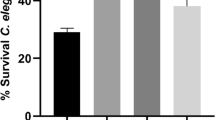Abstract
We examined the anti-inflammatory activities of 10 lactic acid bacteria extracts, obtained by lysozyme treatment. Among ferments of the 10 species, Bifidobacterium lactis showed the highest anti-erythema (73.4%) and anti-edema (67.1%) effects. When comparing the anti-inflammatory activities of fermented broth and lactic acid bacteria in fermentation broth, the anti-erythema effect (70.4%) of 37.5 μg B. lactis hydrolysate, hydrolyzed enzymatically with 2.0 mg/mL lysozyme, was superior to that of the supernatant (68.5%). The anti-edema effect (74.2%) of 50 μg B. lactis hydrolysate, hydrolyzed enzymatically with 2.0 mg/mL lysozyme, was superior to that of the supernatant (68.5%). These results suggest that B. lactis hydrolysate may be useful as a source of anti-inflammatory agents for dermal applications.
Similar content being viewed by others
References
Blandino, G., Fazio, D. & Di Marco, R. Probiotics: overview of microbiological and immunological characteristics. Expert. Rev. Anti. Infect. Ther. 6, 497–508 (2008).
Al-Ghazzewi, F. H. & Tester, R. F. Impact of prebiotics and probiotics on skin health. Benef. Microbes 5, 99–107 (2014).
Tomita, T. & Nagase, T. Defensins as a mechanism of host defense and innate immunity. Nippon Ronen Igakkai Zasshi 38, 440–443 (2001).
Sang, Y. & Blecha, F. Antimicrobial peptides and bacteriocins: alternatives to traditional antibiotics. Anim. Health Res. Rev. 9, 227–235 (2008).
Baba, H. et al. Oral intake of Lactobacillus helveticus-fermented milk whey decreased transepidermal water loss and prevented the onset of sodium dodecylsulfateinduced dermatitis in mice. Biosci. Biotechnol. Biochem. 74, 18–23 (2010).
Won, T. J. et al. Oral administration of Lactobacillus strains from Kimchi inhibits atopic dermatitis in NC/Nga mice. J. Appl. Microbiol. 110, 1195–1202 (2011).
Kano, H. et al. Oral administration of Lactobacillus delbrueckii subspecies bulgaricus OLL1073R-1 suppresses inflammation by decreasing interleukin-6 responses in a murine model of atopic dermatitis. J. Dairy Sci. 96, 3525–3534 (2013).
Kim, H. et al. Oral administration of Lactobacillus plantarum lysates attenuates the development of atopic dermatitis lesions in mouse models. J. Microbiol. 53, 47–52 (2015).
Viljanen, M. et al. Probiotics in the treatment of atopic eczema/dermatitis syndrome in infants: a double-blind placebo-controlled trial. Allergy 60, 494–500 (2005).
Ogawa, T. et al. A new symbiotic, Lactobacillus casei subsp. casei together with dextran, reduces murine and human allergic reaction. FEMS Immunol. Med. Microbiol. 46, 400–409 (2006).
Han, Y. et al. A randomized trial of Lactobacillus plantarum CJLP133 for the treatment of atopic dermatitis. Pediatr. Allergy Immunol. 23, 667–673 (2012).
Boyle, R. J., Lahtinen, S. J. & Tang, M. L. K. in Probiotics and skin (Edn A. Pappas) 111–127 (Springer, New York, 2011).
Jeong, J. H., Lee, C. Y. & Chung, D. K. Probiotic lactic acid bacteria and skin health. Crit. Rev. Food Sci. Nutr. doi: 10.1080/10408398.2013.834874 (2015).
Muizzuddin, N., Maher, W., Sullivan, M., Schnittger, S. & Mammone, T. Physiological effect of a probiotic on skin. J. Cosmet. Sci. 63, 385–395 (2012).
Chung, D. K. et al. Anti-inflammatory, skin whitening and anti-aging composition comprising supernatant of lactic acid bacteria lysate. KR-0003158 (2013).
Guéniche, A. et al. Bifidobacterium longum lysate, a new ingredient for reactive skin. Exp. Dermatol. 19, 1–8 (2010).
Khan, M. N. A. et al. Effects of the brown seaweed Undaria pinnatifida on erythematous inflammation assessed using digital photo analysis. Phytother. Res. 22, 634–639 (2008).
Mattsson, U., Krogstad, A. L., Pegenius, G., Elam, M. & Jonte, M. Assessment of erythema and skin perfusion by digital image analysis and scanner laser Doppler. Skin Res. Technol. 3, 53–59 (1997).
Khan, M. N. A. et al. Anti-edema effects of brown seaweed (Undaria pinnatifida) extract on phorbol 12-myristate 13-acetate-induced mouse ear inflammation. Am. J. Chin. Med. 37, 373–381 (2009).
Klinger, M. H. & Jelkmann, W. Review: role of blood platelets in infection and inflammation. J. Interferon Cytokine Res. 22, 913–922 (2002).
Sullivan, M., Schnittger, S. F., Mammone, T. & Goyarts, E. C. Skin treatment method with Lactobacillus extract. US Patent 7, 510, 734, B2 (2009).
Menard, S. et al. Lactic acid bacteria secrete metabolites retaining anti-inflammatory properties after intestinal transport. Gut. 53, 821–828 (2004).
Versalovic, J., Pena, J. & Connolly, E. Anti-inflammatory activity from lactic acid bacteria. US Patent Application No. 10/767, 317 (2004).
Jones, S. E. & Versalovic, J. Probiotic Lactobacillus reuteri biofilms produce antimicrobial and anti-inflammatory factors. BMC Microbiol. 9, 35 (2009).
Kano, H., Kita, J., Makino, S., Ikegami, S. & Itoh, H. Oral administration of Lactobacillus delbrueckii subspecies bulgaricus OLL1073R-1 suppresses inflammation by decreasing interleukin-6 responses in a murine model of atopic dermatitis. J. Dairy Sci. 96, 3525–3534 (2013).
Kang, J. Y., Choi, J. S., Park, N. G., Ahn, D. H. & Hong, Y. K. In Vivo antipyretic, analgesic, and anti-inflammatory activities of the brown alga Ecklonia cava extracts in mice. Fish. Aquat. Sci. 15, 73–76 (2012).
Author information
Authors and Affiliations
Corresponding author
Additional information
These authors contributed equally to this work.
Rights and permissions
About this article
Cite this article
Choi, JS., Jang, D.B., Cho, H.K. et al. Anti-erythema and anti-edema activities of lactic acid bacteria extracts in mice. Toxicol. Environ. Health Sci. 9, 82–87 (2017). https://doi.org/10.1007/s13530-017-0307-3
Received:
Revised:
Accepted:
Published:
Issue Date:
DOI: https://doi.org/10.1007/s13530-017-0307-3




